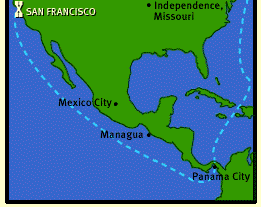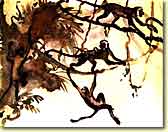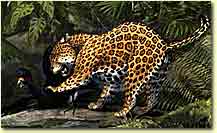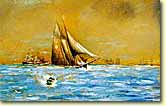

|


"The only sounds in that leafy wilderness were the chattering of monkeys as they cracked the palm nuts, and the scream of parrots, flying from tree to tree."
Bayard Taylor, journalist who covered the Gold Rush
from Gold Rush: A Literary Exploration, edited by Michael Kowalewski
 For many forty-niners, the Panama shortcut was irresistible. It cut 8,000 miles
and months of travel off the sea voyage around Cape Horn, at the tip of South
America. And a trip through the jungles of Panama, with their brightly-colored
birds and flowers, seemed like an exotic adventure. For many forty-niners, the Panama shortcut was irresistible. It cut 8,000 miles
and months of travel off the sea voyage around Cape Horn, at the tip of South
America. And a trip through the jungles of Panama, with their brightly-colored
birds and flowers, seemed like an exotic adventure.
The cross-Panama journey began on the Caribbean coast, at the mouth of the
Chagres river. There, forty-niners stepped on board a bungo, a type of
Panamanian canoe. At first, native Panamanians charged about $5 for the 3 to 4
day river journey. But when they realized how anxious the gold seekers were to
get across Panama, the price quickly rose.
 As the gold seekers traveled, they saw a jungle landscape that seemed like
something from a dream: dense thickets of mangrove trees, dazzling tropical
flowers, and exotic animals such as crocodiles, parrots, and jaguars. Some
forty-niners even got the chance to sample roast iguana or monkey meat, cooked
over a campfire. As the gold seekers traveled, they saw a jungle landscape that seemed like
something from a dream: dense thickets of mangrove trees, dazzling tropical
flowers, and exotic animals such as crocodiles, parrots, and jaguars. Some
forty-niners even got the chance to sample roast iguana or monkey meat, cooked
over a campfire.
The river journey was the easy part. Soon, the bungoes landed, and the men set
out on horses or mules into the steaming jungle. Bodies of dead horses and
mules marked the 50-mile trail. Death lurked everywhere, in the form of
diseases such as malaria, yellow fever, and cholera.
Of the thousands of forty-niners who attempted the Panama crossing, some died
of disease and never made it out of the jungle. Most did, arriving at Panama
City, a small outpost on the Pacific coast. There, many miners got a surprise.
There weren't any boats to take them to California. They would have to wait.
  Regular passenger service to San Francisco began in late 1849. Before that,
thousands of gold seekers became stranded in Panama City--for days or even
weeks. When ships arrived, miners swarmed them. Often, forty-niners paid
extremely high prices for passage. But most thought it was worth it. They were
headed to California, the land of gold. And they were sure they'd strike it
rich. Regular passenger service to San Francisco began in late 1849. Before that,
thousands of gold seekers became stranded in Panama City--for days or even
weeks. When ships arrived, miners swarmed them. Often, forty-niners paid
extremely high prices for passage. But most thought it was worth it. They were
headed to California, the land of gold. And they were sure they'd strike it
rich.
Oregon-California Trail | Around Cape Horn
|

